Report on Assistive Technology to Support Independent Living for Sally
VerifiedAdded on 2020/06/04
|10
|2950
|26
Report
AI Summary
This report investigates the role of assistive technology in supporting independent living, focusing on a case study involving a 42-year-old woman named Sally with disabilities. It explores various technologies, such as pocket coaches, spinner knobs, and special keyboards, and how they can aid in daily activities. The report identifies technological barriers, including resistance to technology and budget constraints, while also highlighting the benefits of assistive technology, such as promoting health and safety and improving the quality of care. Ethical considerations in the use of these technologies are also discussed, along with the impact of emerging technologies. The report concludes by identifying Sally's specific needs and recommending appropriate assistive devices to evaluate useful technologies for people with disabilities.

SUPPORTING
INDEPENDENT LIVING
INDEPENDENT LIVING
Paraphrase This Document
Need a fresh take? Get an instant paraphrase of this document with our AI Paraphraser
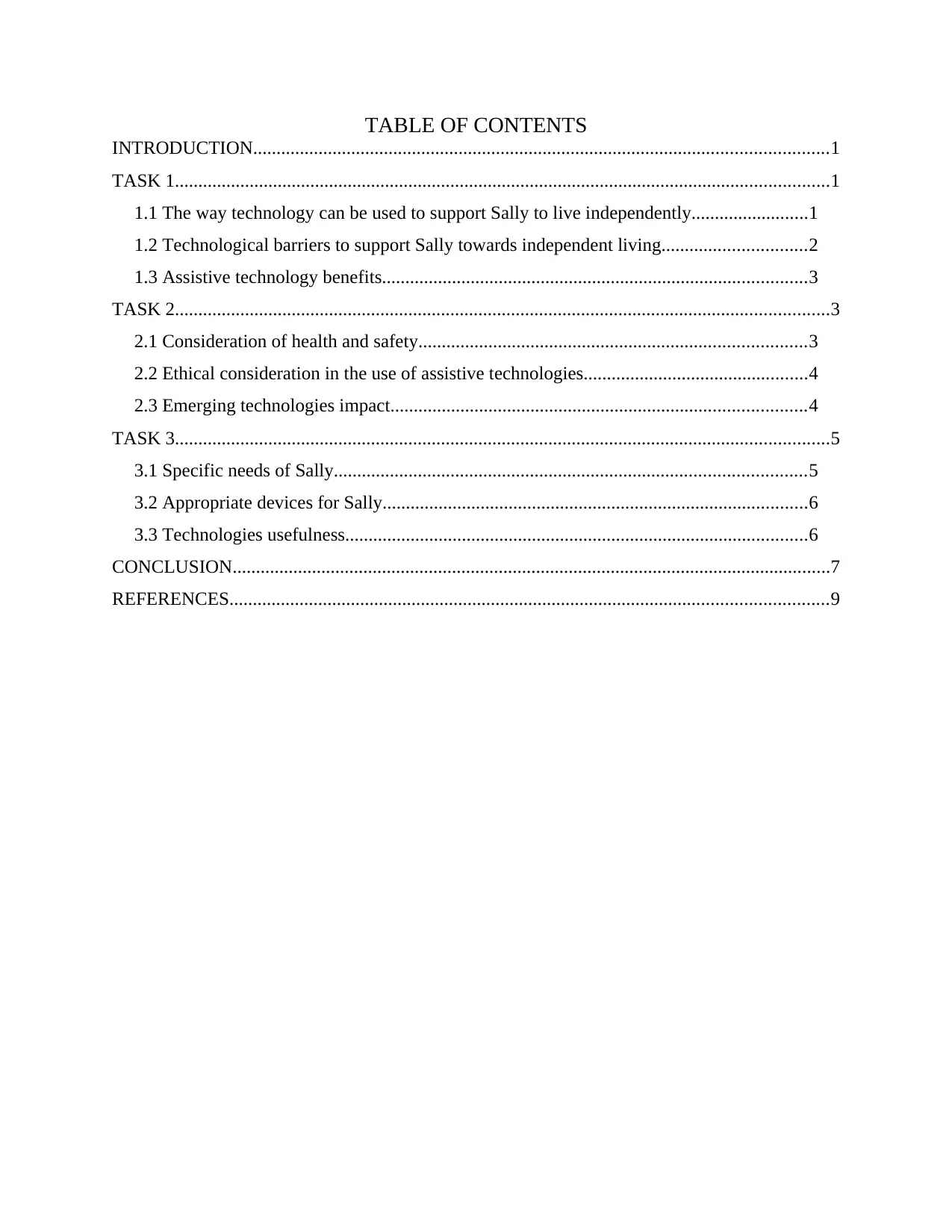
TABLE OF CONTENTS
INTRODUCTION...........................................................................................................................1
TASK 1............................................................................................................................................1
1.1 The way technology can be used to support Sally to live independently.........................1
1.2 Technological barriers to support Sally towards independent living...............................2
1.3 Assistive technology benefits...........................................................................................3
TASK 2............................................................................................................................................3
2.1 Consideration of health and safety...................................................................................3
2.2 Ethical consideration in the use of assistive technologies................................................4
2.3 Emerging technologies impact.........................................................................................4
TASK 3............................................................................................................................................5
3.1 Specific needs of Sally.....................................................................................................5
3.2 Appropriate devices for Sally...........................................................................................6
3.3 Technologies usefulness...................................................................................................6
CONCLUSION................................................................................................................................7
REFERENCES................................................................................................................................9
INTRODUCTION...........................................................................................................................1
TASK 1............................................................................................................................................1
1.1 The way technology can be used to support Sally to live independently.........................1
1.2 Technological barriers to support Sally towards independent living...............................2
1.3 Assistive technology benefits...........................................................................................3
TASK 2............................................................................................................................................3
2.1 Consideration of health and safety...................................................................................3
2.2 Ethical consideration in the use of assistive technologies................................................4
2.3 Emerging technologies impact.........................................................................................4
TASK 3............................................................................................................................................5
3.1 Specific needs of Sally.....................................................................................................5
3.2 Appropriate devices for Sally...........................................................................................6
3.3 Technologies usefulness...................................................................................................6
CONCLUSION................................................................................................................................7
REFERENCES................................................................................................................................9
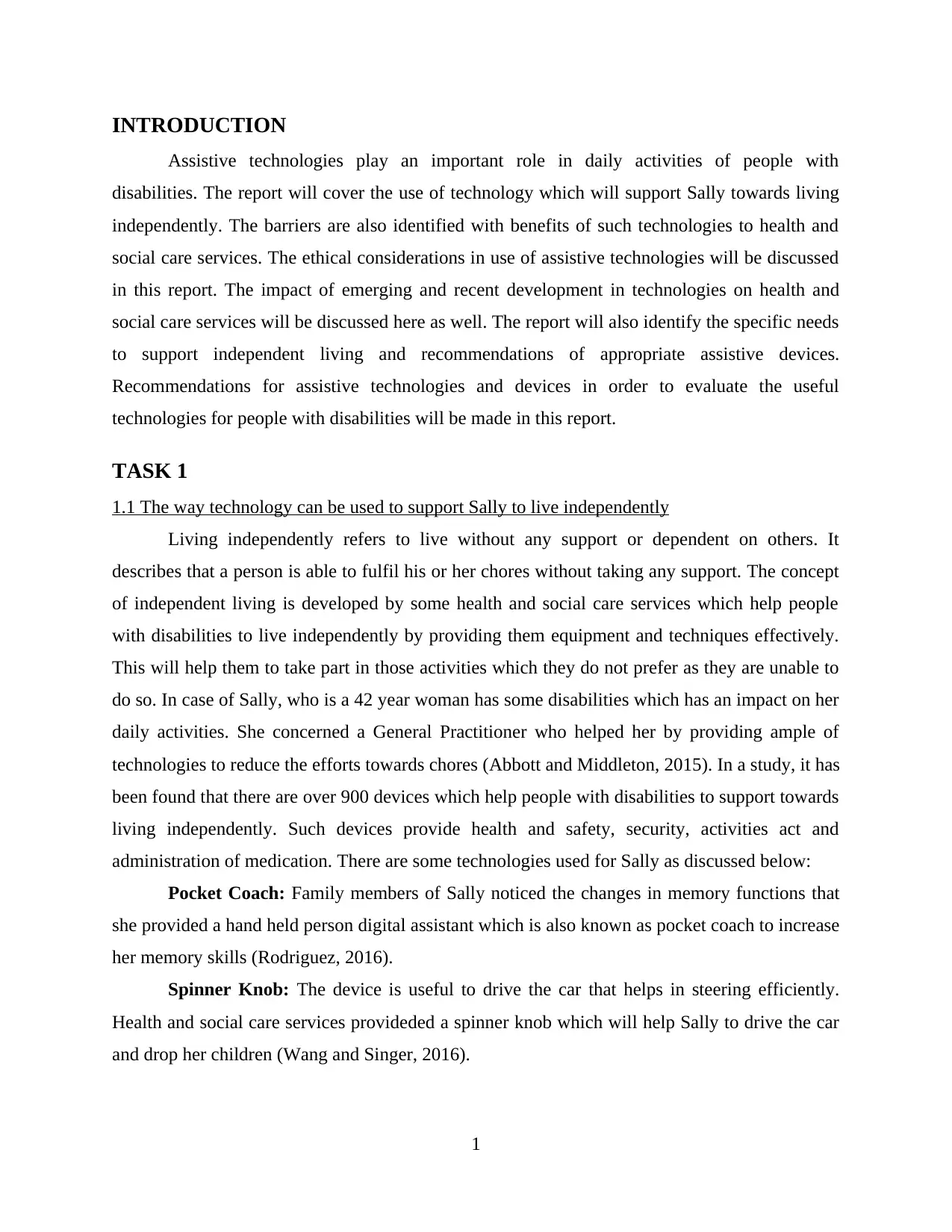
INTRODUCTION
Assistive technologies play an important role in daily activities of people with
disabilities. The report will cover the use of technology which will support Sally towards living
independently. The barriers are also identified with benefits of such technologies to health and
social care services. The ethical considerations in use of assistive technologies will be discussed
in this report. The impact of emerging and recent development in technologies on health and
social care services will be discussed here as well. The report will also identify the specific needs
to support independent living and recommendations of appropriate assistive devices.
Recommendations for assistive technologies and devices in order to evaluate the useful
technologies for people with disabilities will be made in this report.
TASK 1
1.1 The way technology can be used to support Sally to live independently
Living independently refers to live without any support or dependent on others. It
describes that a person is able to fulfil his or her chores without taking any support. The concept
of independent living is developed by some health and social care services which help people
with disabilities to live independently by providing them equipment and techniques effectively.
This will help them to take part in those activities which they do not prefer as they are unable to
do so. In case of Sally, who is a 42 year woman has some disabilities which has an impact on her
daily activities. She concerned a General Practitioner who helped her by providing ample of
technologies to reduce the efforts towards chores (Abbott and Middleton, 2015). In a study, it has
been found that there are over 900 devices which help people with disabilities to support towards
living independently. Such devices provide health and safety, security, activities act and
administration of medication. There are some technologies used for Sally as discussed below:
Pocket Coach: Family members of Sally noticed the changes in memory functions that
she provided a hand held person digital assistant which is also known as pocket coach to increase
her memory skills (Rodriguez, 2016).
Spinner Knob: The device is useful to drive the car that helps in steering efficiently.
Health and social care services provideded a spinner knob which will help Sally to drive the car
and drop her children (Wang and Singer, 2016).
1
Assistive technologies play an important role in daily activities of people with
disabilities. The report will cover the use of technology which will support Sally towards living
independently. The barriers are also identified with benefits of such technologies to health and
social care services. The ethical considerations in use of assistive technologies will be discussed
in this report. The impact of emerging and recent development in technologies on health and
social care services will be discussed here as well. The report will also identify the specific needs
to support independent living and recommendations of appropriate assistive devices.
Recommendations for assistive technologies and devices in order to evaluate the useful
technologies for people with disabilities will be made in this report.
TASK 1
1.1 The way technology can be used to support Sally to live independently
Living independently refers to live without any support or dependent on others. It
describes that a person is able to fulfil his or her chores without taking any support. The concept
of independent living is developed by some health and social care services which help people
with disabilities to live independently by providing them equipment and techniques effectively.
This will help them to take part in those activities which they do not prefer as they are unable to
do so. In case of Sally, who is a 42 year woman has some disabilities which has an impact on her
daily activities. She concerned a General Practitioner who helped her by providing ample of
technologies to reduce the efforts towards chores (Abbott and Middleton, 2015). In a study, it has
been found that there are over 900 devices which help people with disabilities to support towards
living independently. Such devices provide health and safety, security, activities act and
administration of medication. There are some technologies used for Sally as discussed below:
Pocket Coach: Family members of Sally noticed the changes in memory functions that
she provided a hand held person digital assistant which is also known as pocket coach to increase
her memory skills (Rodriguez, 2016).
Spinner Knob: The device is useful to drive the car that helps in steering efficiently.
Health and social care services provideded a spinner knob which will help Sally to drive the car
and drop her children (Wang and Singer, 2016).
1
⊘ This is a preview!⊘
Do you want full access?
Subscribe today to unlock all pages.

Trusted by 1+ million students worldwide
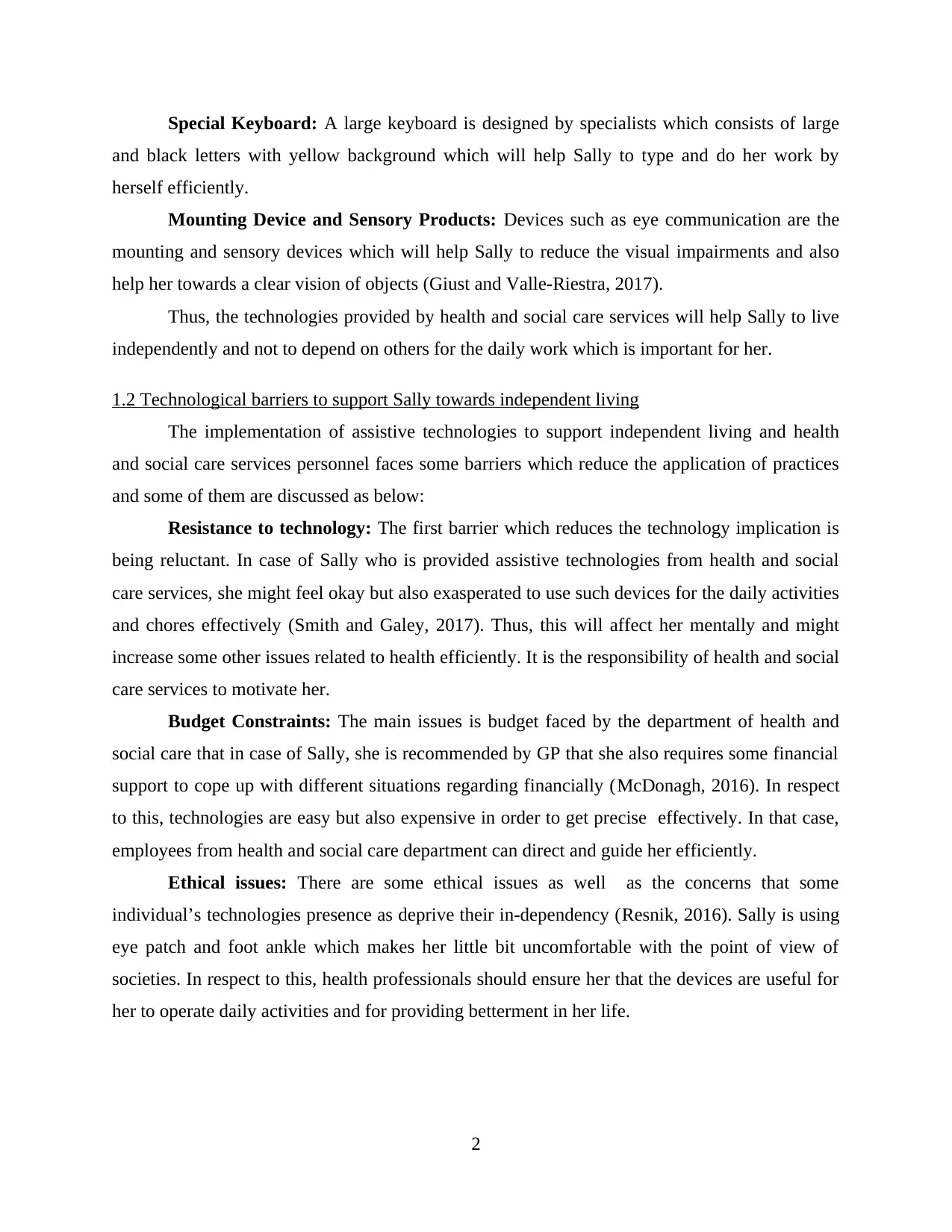
Special Keyboard: A large keyboard is designed by specialists which consists of large
and black letters with yellow background which will help Sally to type and do her work by
herself efficiently.
Mounting Device and Sensory Products: Devices such as eye communication are the
mounting and sensory devices which will help Sally to reduce the visual impairments and also
help her towards a clear vision of objects (Giust and Valle-Riestra, 2017).
Thus, the technologies provided by health and social care services will help Sally to live
independently and not to depend on others for the daily work which is important for her.
1.2 Technological barriers to support Sally towards independent living
The implementation of assistive technologies to support independent living and health
and social care services personnel faces some barriers which reduce the application of practices
and some of them are discussed as below:
Resistance to technology: The first barrier which reduces the technology implication is
being reluctant. In case of Sally who is provided assistive technologies from health and social
care services, she might feel okay but also exasperated to use such devices for the daily activities
and chores effectively (Smith and Galey, 2017). Thus, this will affect her mentally and might
increase some other issues related to health efficiently. It is the responsibility of health and social
care services to motivate her.
Budget Constraints: The main issues is budget faced by the department of health and
social care that in case of Sally, she is recommended by GP that she also requires some financial
support to cope up with different situations regarding financially (McDonagh, 2016). In respect
to this, technologies are easy but also expensive in order to get precise effectively. In that case,
employees from health and social care department can direct and guide her efficiently.
Ethical issues: There are some ethical issues as well as the concerns that some
individual’s technologies presence as deprive their in-dependency (Resnik, 2016). Sally is using
eye patch and foot ankle which makes her little bit uncomfortable with the point of view of
societies. In respect to this, health professionals should ensure her that the devices are useful for
her to operate daily activities and for providing betterment in her life.
2
and black letters with yellow background which will help Sally to type and do her work by
herself efficiently.
Mounting Device and Sensory Products: Devices such as eye communication are the
mounting and sensory devices which will help Sally to reduce the visual impairments and also
help her towards a clear vision of objects (Giust and Valle-Riestra, 2017).
Thus, the technologies provided by health and social care services will help Sally to live
independently and not to depend on others for the daily work which is important for her.
1.2 Technological barriers to support Sally towards independent living
The implementation of assistive technologies to support independent living and health
and social care services personnel faces some barriers which reduce the application of practices
and some of them are discussed as below:
Resistance to technology: The first barrier which reduces the technology implication is
being reluctant. In case of Sally who is provided assistive technologies from health and social
care services, she might feel okay but also exasperated to use such devices for the daily activities
and chores effectively (Smith and Galey, 2017). Thus, this will affect her mentally and might
increase some other issues related to health efficiently. It is the responsibility of health and social
care services to motivate her.
Budget Constraints: The main issues is budget faced by the department of health and
social care that in case of Sally, she is recommended by GP that she also requires some financial
support to cope up with different situations regarding financially (McDonagh, 2016). In respect
to this, technologies are easy but also expensive in order to get precise effectively. In that case,
employees from health and social care department can direct and guide her efficiently.
Ethical issues: There are some ethical issues as well as the concerns that some
individual’s technologies presence as deprive their in-dependency (Resnik, 2016). Sally is using
eye patch and foot ankle which makes her little bit uncomfortable with the point of view of
societies. In respect to this, health professionals should ensure her that the devices are useful for
her to operate daily activities and for providing betterment in her life.
2
Paraphrase This Document
Need a fresh take? Get an instant paraphrase of this document with our AI Paraphraser
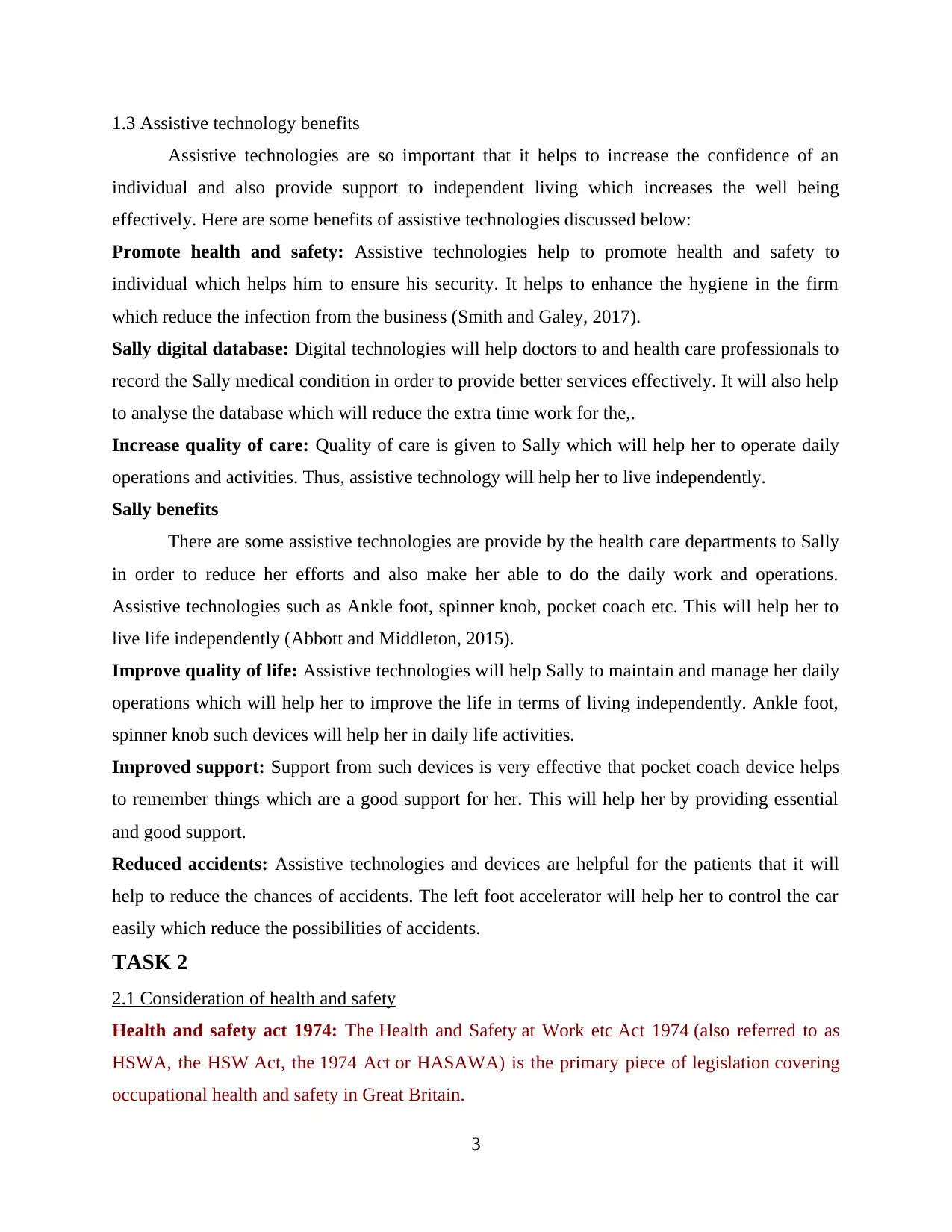
1.3 Assistive technology benefits
Assistive technologies are so important that it helps to increase the confidence of an
individual and also provide support to independent living which increases the well being
effectively. Here are some benefits of assistive technologies discussed below:
Promote health and safety: Assistive technologies help to promote health and safety to
individual which helps him to ensure his security. It helps to enhance the hygiene in the firm
which reduce the infection from the business (Smith and Galey, 2017).
Sally digital database: Digital technologies will help doctors to and health care professionals to
record the Sally medical condition in order to provide better services effectively. It will also help
to analyse the database which will reduce the extra time work for the,.
Increase quality of care: Quality of care is given to Sally which will help her to operate daily
operations and activities. Thus, assistive technology will help her to live independently.
Sally benefits
There are some assistive technologies are provide by the health care departments to Sally
in order to reduce her efforts and also make her able to do the daily work and operations.
Assistive technologies such as Ankle foot, spinner knob, pocket coach etc. This will help her to
live life independently (Abbott and Middleton, 2015).
Improve quality of life: Assistive technologies will help Sally to maintain and manage her daily
operations which will help her to improve the life in terms of living independently. Ankle foot,
spinner knob such devices will help her in daily life activities.
Improved support: Support from such devices is very effective that pocket coach device helps
to remember things which are a good support for her. This will help her by providing essential
and good support.
Reduced accidents: Assistive technologies and devices are helpful for the patients that it will
help to reduce the chances of accidents. The left foot accelerator will help her to control the car
easily which reduce the possibilities of accidents.
TASK 2
2.1 Consideration of health and safety
Health and safety act 1974: The Health and Safety at Work etc Act 1974 (also referred to as
HSWA, the HSW Act, the 1974 Act or HASAWA) is the primary piece of legislation covering
occupational health and safety in Great Britain.
3
Assistive technologies are so important that it helps to increase the confidence of an
individual and also provide support to independent living which increases the well being
effectively. Here are some benefits of assistive technologies discussed below:
Promote health and safety: Assistive technologies help to promote health and safety to
individual which helps him to ensure his security. It helps to enhance the hygiene in the firm
which reduce the infection from the business (Smith and Galey, 2017).
Sally digital database: Digital technologies will help doctors to and health care professionals to
record the Sally medical condition in order to provide better services effectively. It will also help
to analyse the database which will reduce the extra time work for the,.
Increase quality of care: Quality of care is given to Sally which will help her to operate daily
operations and activities. Thus, assistive technology will help her to live independently.
Sally benefits
There are some assistive technologies are provide by the health care departments to Sally
in order to reduce her efforts and also make her able to do the daily work and operations.
Assistive technologies such as Ankle foot, spinner knob, pocket coach etc. This will help her to
live life independently (Abbott and Middleton, 2015).
Improve quality of life: Assistive technologies will help Sally to maintain and manage her daily
operations which will help her to improve the life in terms of living independently. Ankle foot,
spinner knob such devices will help her in daily life activities.
Improved support: Support from such devices is very effective that pocket coach device helps
to remember things which are a good support for her. This will help her by providing essential
and good support.
Reduced accidents: Assistive technologies and devices are helpful for the patients that it will
help to reduce the chances of accidents. The left foot accelerator will help her to control the car
easily which reduce the possibilities of accidents.
TASK 2
2.1 Consideration of health and safety
Health and safety act 1974: The Health and Safety at Work etc Act 1974 (also referred to as
HSWA, the HSW Act, the 1974 Act or HASAWA) is the primary piece of legislation covering
occupational health and safety in Great Britain.
3
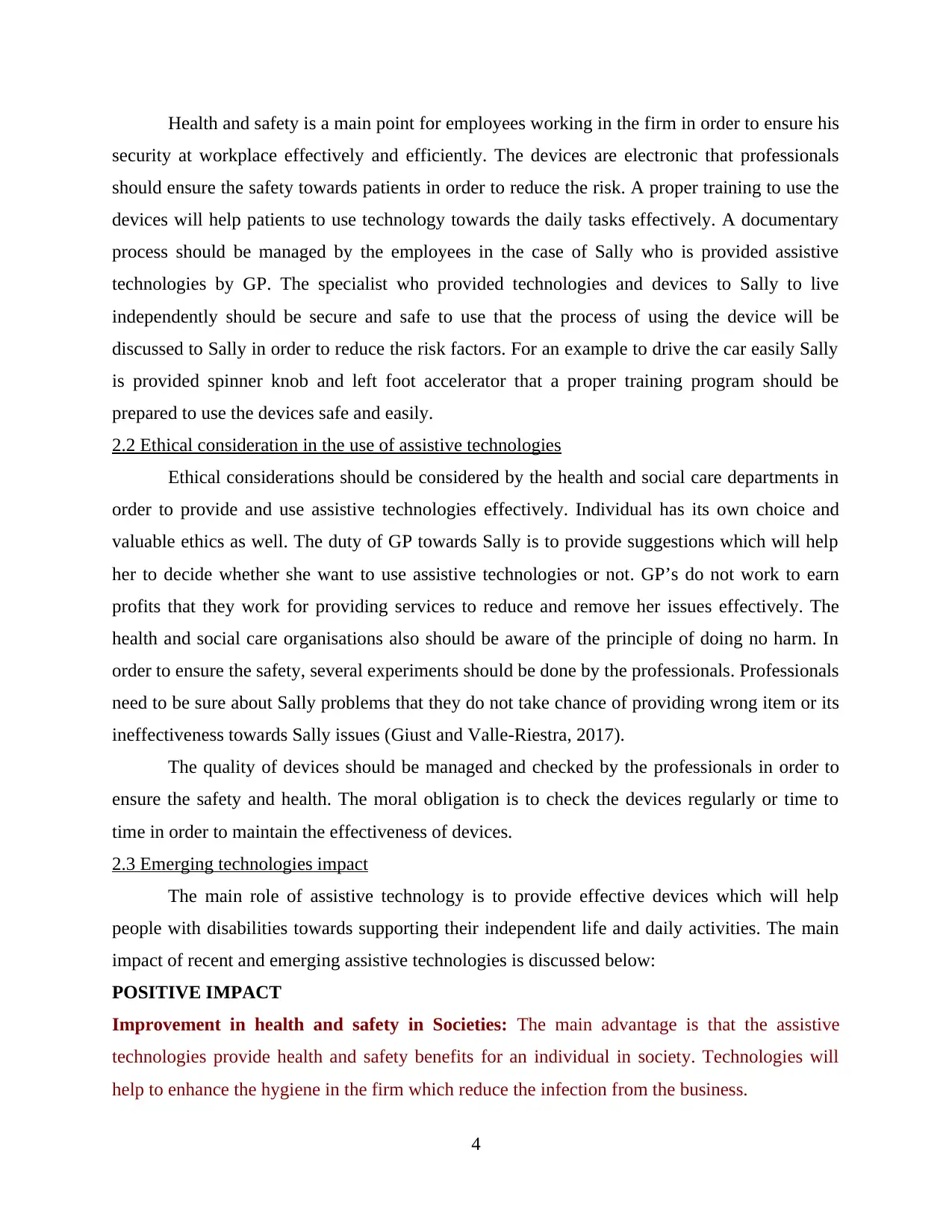
Health and safety is a main point for employees working in the firm in order to ensure his
security at workplace effectively and efficiently. The devices are electronic that professionals
should ensure the safety towards patients in order to reduce the risk. A proper training to use the
devices will help patients to use technology towards the daily tasks effectively. A documentary
process should be managed by the employees in the case of Sally who is provided assistive
technologies by GP. The specialist who provided technologies and devices to Sally to live
independently should be secure and safe to use that the process of using the device will be
discussed to Sally in order to reduce the risk factors. For an example to drive the car easily Sally
is provided spinner knob and left foot accelerator that a proper training program should be
prepared to use the devices safe and easily.
2.2 Ethical consideration in the use of assistive technologies
Ethical considerations should be considered by the health and social care departments in
order to provide and use assistive technologies effectively. Individual has its own choice and
valuable ethics as well. The duty of GP towards Sally is to provide suggestions which will help
her to decide whether she want to use assistive technologies or not. GP’s do not work to earn
profits that they work for providing services to reduce and remove her issues effectively. The
health and social care organisations also should be aware of the principle of doing no harm. In
order to ensure the safety, several experiments should be done by the professionals. Professionals
need to be sure about Sally problems that they do not take chance of providing wrong item or its
ineffectiveness towards Sally issues (Giust and Valle-Riestra, 2017).
The quality of devices should be managed and checked by the professionals in order to
ensure the safety and health. The moral obligation is to check the devices regularly or time to
time in order to maintain the effectiveness of devices.
2.3 Emerging technologies impact
The main role of assistive technology is to provide effective devices which will help
people with disabilities towards supporting their independent life and daily activities. The main
impact of recent and emerging assistive technologies is discussed below:
POSITIVE IMPACT
Improvement in health and safety in Societies: The main advantage is that the assistive
technologies provide health and safety benefits for an individual in society. Technologies will
help to enhance the hygiene in the firm which reduce the infection from the business.
4
security at workplace effectively and efficiently. The devices are electronic that professionals
should ensure the safety towards patients in order to reduce the risk. A proper training to use the
devices will help patients to use technology towards the daily tasks effectively. A documentary
process should be managed by the employees in the case of Sally who is provided assistive
technologies by GP. The specialist who provided technologies and devices to Sally to live
independently should be secure and safe to use that the process of using the device will be
discussed to Sally in order to reduce the risk factors. For an example to drive the car easily Sally
is provided spinner knob and left foot accelerator that a proper training program should be
prepared to use the devices safe and easily.
2.2 Ethical consideration in the use of assistive technologies
Ethical considerations should be considered by the health and social care departments in
order to provide and use assistive technologies effectively. Individual has its own choice and
valuable ethics as well. The duty of GP towards Sally is to provide suggestions which will help
her to decide whether she want to use assistive technologies or not. GP’s do not work to earn
profits that they work for providing services to reduce and remove her issues effectively. The
health and social care organisations also should be aware of the principle of doing no harm. In
order to ensure the safety, several experiments should be done by the professionals. Professionals
need to be sure about Sally problems that they do not take chance of providing wrong item or its
ineffectiveness towards Sally issues (Giust and Valle-Riestra, 2017).
The quality of devices should be managed and checked by the professionals in order to
ensure the safety and health. The moral obligation is to check the devices regularly or time to
time in order to maintain the effectiveness of devices.
2.3 Emerging technologies impact
The main role of assistive technology is to provide effective devices which will help
people with disabilities towards supporting their independent life and daily activities. The main
impact of recent and emerging assistive technologies is discussed below:
POSITIVE IMPACT
Improvement in health and safety in Societies: The main advantage is that the assistive
technologies provide health and safety benefits for an individual in society. Technologies will
help to enhance the hygiene in the firm which reduce the infection from the business.
4
⊘ This is a preview!⊘
Do you want full access?
Subscribe today to unlock all pages.

Trusted by 1+ million students worldwide
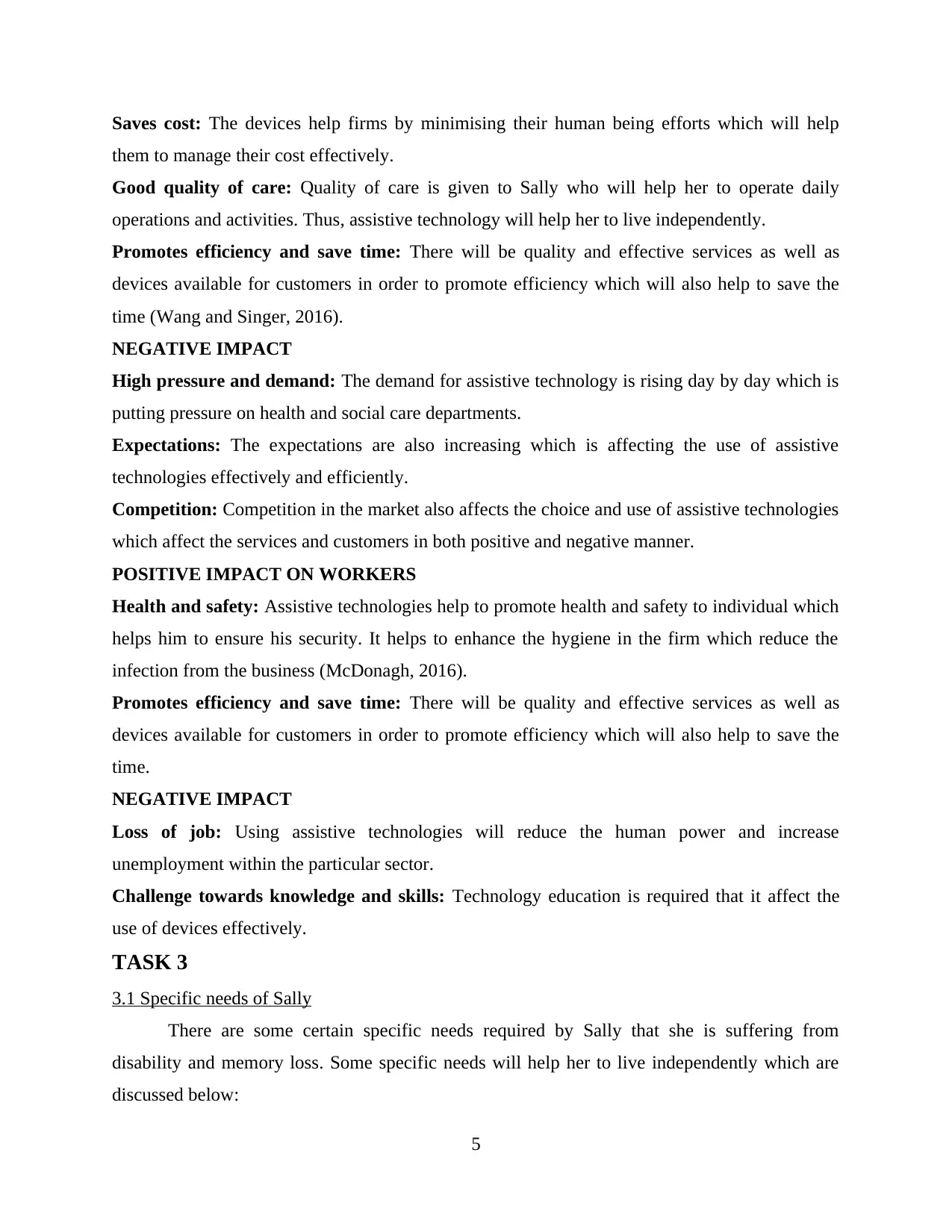
Saves cost: The devices help firms by minimising their human being efforts which will help
them to manage their cost effectively.
Good quality of care: Quality of care is given to Sally who will help her to operate daily
operations and activities. Thus, assistive technology will help her to live independently.
Promotes efficiency and save time: There will be quality and effective services as well as
devices available for customers in order to promote efficiency which will also help to save the
time (Wang and Singer, 2016).
NEGATIVE IMPACT
High pressure and demand: The demand for assistive technology is rising day by day which is
putting pressure on health and social care departments.
Expectations: The expectations are also increasing which is affecting the use of assistive
technologies effectively and efficiently.
Competition: Competition in the market also affects the choice and use of assistive technologies
which affect the services and customers in both positive and negative manner.
POSITIVE IMPACT ON WORKERS
Health and safety: Assistive technologies help to promote health and safety to individual which
helps him to ensure his security. It helps to enhance the hygiene in the firm which reduce the
infection from the business (McDonagh, 2016).
Promotes efficiency and save time: There will be quality and effective services as well as
devices available for customers in order to promote efficiency which will also help to save the
time.
NEGATIVE IMPACT
Loss of job: Using assistive technologies will reduce the human power and increase
unemployment within the particular sector.
Challenge towards knowledge and skills: Technology education is required that it affect the
use of devices effectively.
TASK 3
3.1 Specific needs of Sally
There are some certain specific needs required by Sally that she is suffering from
disability and memory loss. Some specific needs will help her to live independently which are
discussed below:
5
them to manage their cost effectively.
Good quality of care: Quality of care is given to Sally who will help her to operate daily
operations and activities. Thus, assistive technology will help her to live independently.
Promotes efficiency and save time: There will be quality and effective services as well as
devices available for customers in order to promote efficiency which will also help to save the
time (Wang and Singer, 2016).
NEGATIVE IMPACT
High pressure and demand: The demand for assistive technology is rising day by day which is
putting pressure on health and social care departments.
Expectations: The expectations are also increasing which is affecting the use of assistive
technologies effectively and efficiently.
Competition: Competition in the market also affects the choice and use of assistive technologies
which affect the services and customers in both positive and negative manner.
POSITIVE IMPACT ON WORKERS
Health and safety: Assistive technologies help to promote health and safety to individual which
helps him to ensure his security. It helps to enhance the hygiene in the firm which reduce the
infection from the business (McDonagh, 2016).
Promotes efficiency and save time: There will be quality and effective services as well as
devices available for customers in order to promote efficiency which will also help to save the
time.
NEGATIVE IMPACT
Loss of job: Using assistive technologies will reduce the human power and increase
unemployment within the particular sector.
Challenge towards knowledge and skills: Technology education is required that it affect the
use of devices effectively.
TASK 3
3.1 Specific needs of Sally
There are some certain specific needs required by Sally that she is suffering from
disability and memory loss. Some specific needs will help her to live independently which are
discussed below:
5
Paraphrase This Document
Need a fresh take? Get an instant paraphrase of this document with our AI Paraphraser
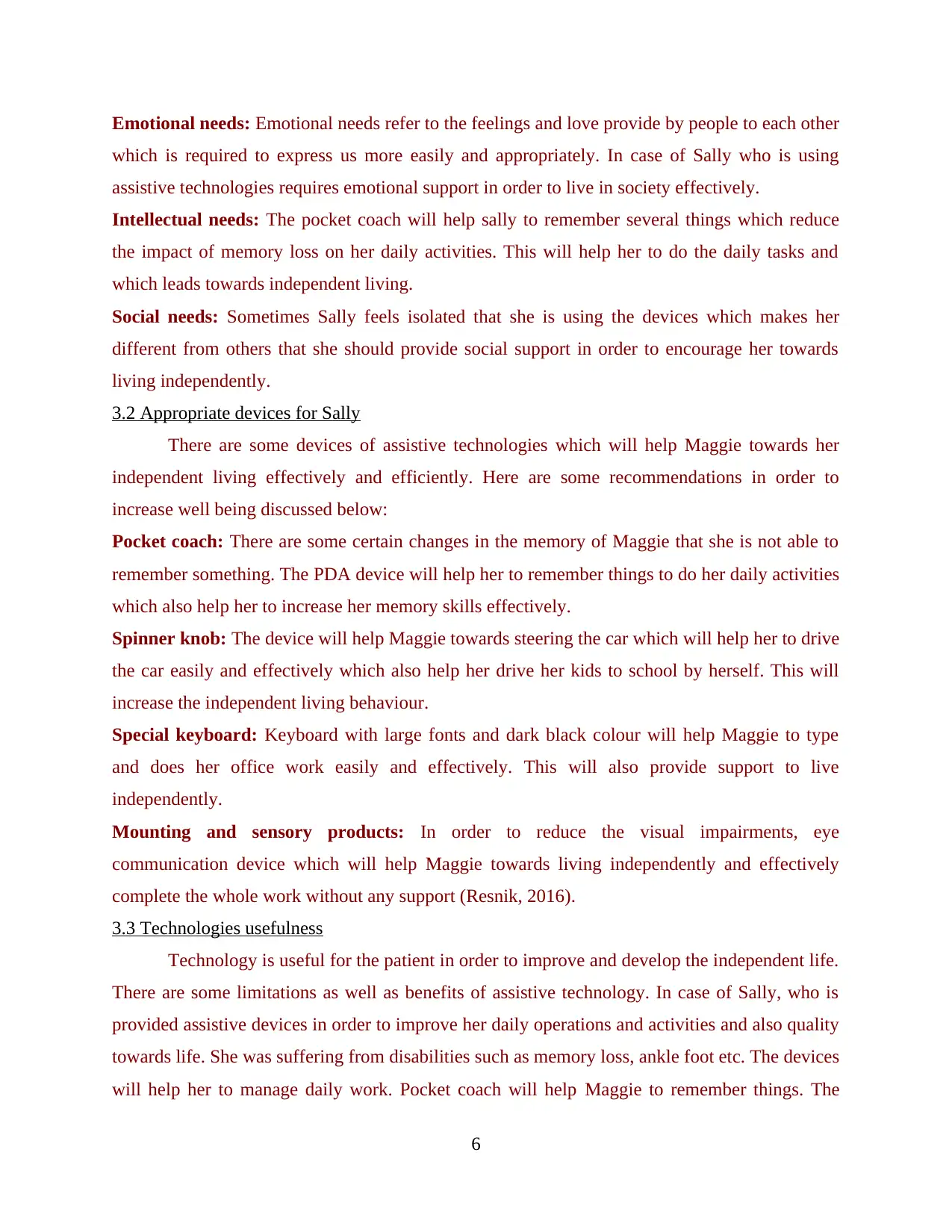
Emotional needs: Emotional needs refer to the feelings and love provide by people to each other
which is required to express us more easily and appropriately. In case of Sally who is using
assistive technologies requires emotional support in order to live in society effectively.
Intellectual needs: The pocket coach will help sally to remember several things which reduce
the impact of memory loss on her daily activities. This will help her to do the daily tasks and
which leads towards independent living.
Social needs: Sometimes Sally feels isolated that she is using the devices which makes her
different from others that she should provide social support in order to encourage her towards
living independently.
3.2 Appropriate devices for Sally
There are some devices of assistive technologies which will help Maggie towards her
independent living effectively and efficiently. Here are some recommendations in order to
increase well being discussed below:
Pocket coach: There are some certain changes in the memory of Maggie that she is not able to
remember something. The PDA device will help her to remember things to do her daily activities
which also help her to increase her memory skills effectively.
Spinner knob: The device will help Maggie towards steering the car which will help her to drive
the car easily and effectively which also help her drive her kids to school by herself. This will
increase the independent living behaviour.
Special keyboard: Keyboard with large fonts and dark black colour will help Maggie to type
and does her office work easily and effectively. This will also provide support to live
independently.
Mounting and sensory products: In order to reduce the visual impairments, eye
communication device which will help Maggie towards living independently and effectively
complete the whole work without any support (Resnik, 2016).
3.3 Technologies usefulness
Technology is useful for the patient in order to improve and develop the independent life.
There are some limitations as well as benefits of assistive technology. In case of Sally, who is
provided assistive devices in order to improve her daily operations and activities and also quality
towards life. She was suffering from disabilities such as memory loss, ankle foot etc. The devices
will help her to manage daily work. Pocket coach will help Maggie to remember things. The
6
which is required to express us more easily and appropriately. In case of Sally who is using
assistive technologies requires emotional support in order to live in society effectively.
Intellectual needs: The pocket coach will help sally to remember several things which reduce
the impact of memory loss on her daily activities. This will help her to do the daily tasks and
which leads towards independent living.
Social needs: Sometimes Sally feels isolated that she is using the devices which makes her
different from others that she should provide social support in order to encourage her towards
living independently.
3.2 Appropriate devices for Sally
There are some devices of assistive technologies which will help Maggie towards her
independent living effectively and efficiently. Here are some recommendations in order to
increase well being discussed below:
Pocket coach: There are some certain changes in the memory of Maggie that she is not able to
remember something. The PDA device will help her to remember things to do her daily activities
which also help her to increase her memory skills effectively.
Spinner knob: The device will help Maggie towards steering the car which will help her to drive
the car easily and effectively which also help her drive her kids to school by herself. This will
increase the independent living behaviour.
Special keyboard: Keyboard with large fonts and dark black colour will help Maggie to type
and does her office work easily and effectively. This will also provide support to live
independently.
Mounting and sensory products: In order to reduce the visual impairments, eye
communication device which will help Maggie towards living independently and effectively
complete the whole work without any support (Resnik, 2016).
3.3 Technologies usefulness
Technology is useful for the patient in order to improve and develop the independent life.
There are some limitations as well as benefits of assistive technology. In case of Sally, who is
provided assistive devices in order to improve her daily operations and activities and also quality
towards life. She was suffering from disabilities such as memory loss, ankle foot etc. The devices
will help her to manage daily work. Pocket coach will help Maggie to remember things. The
6
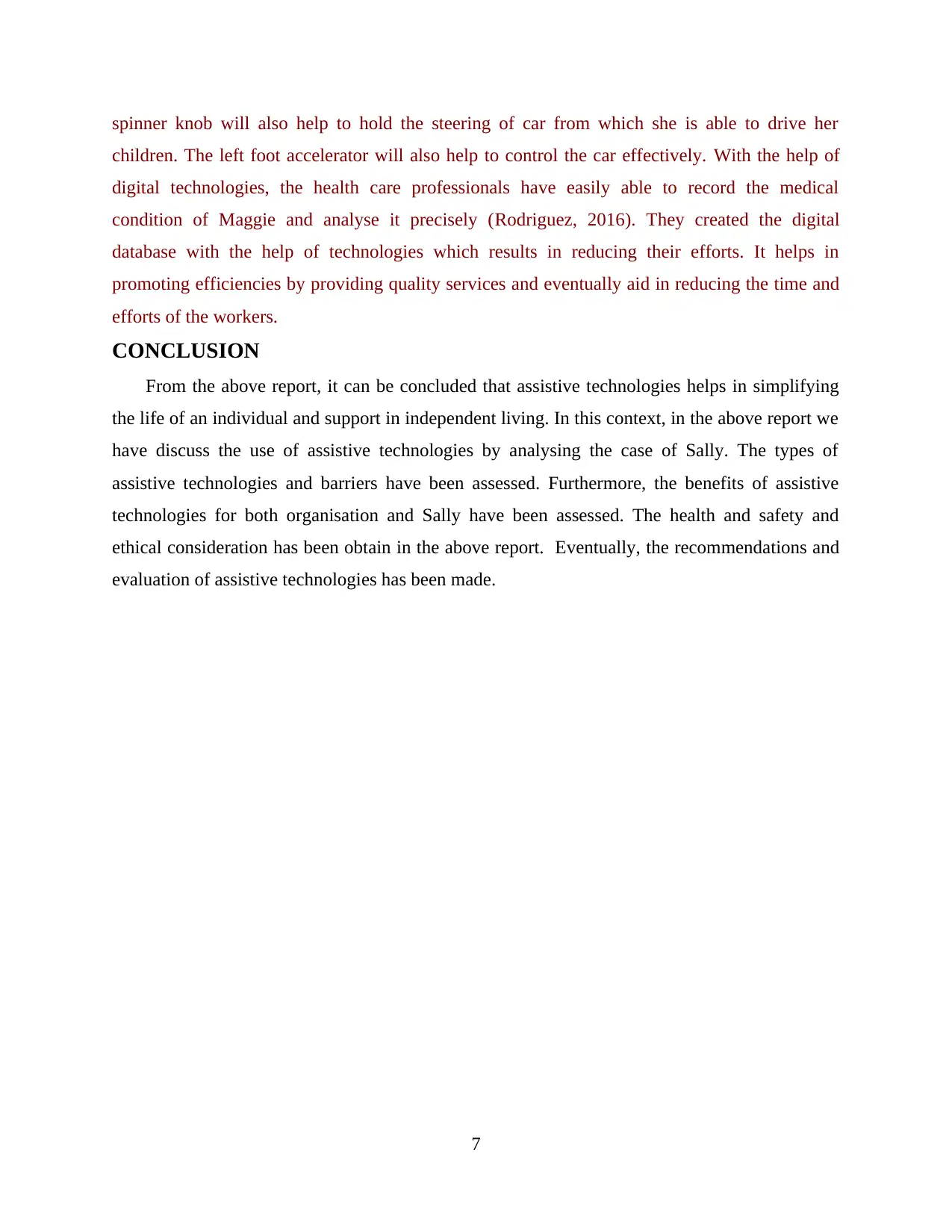
spinner knob will also help to hold the steering of car from which she is able to drive her
children. The left foot accelerator will also help to control the car effectively. With the help of
digital technologies, the health care professionals have easily able to record the medical
condition of Maggie and analyse it precisely (Rodriguez, 2016). They created the digital
database with the help of technologies which results in reducing their efforts. It helps in
promoting efficiencies by providing quality services and eventually aid in reducing the time and
efforts of the workers.
CONCLUSION
From the above report, it can be concluded that assistive technologies helps in simplifying
the life of an individual and support in independent living. In this context, in the above report we
have discuss the use of assistive technologies by analysing the case of Sally. The types of
assistive technologies and barriers have been assessed. Furthermore, the benefits of assistive
technologies for both organisation and Sally have been assessed. The health and safety and
ethical consideration has been obtain in the above report. Eventually, the recommendations and
evaluation of assistive technologies has been made.
7
children. The left foot accelerator will also help to control the car effectively. With the help of
digital technologies, the health care professionals have easily able to record the medical
condition of Maggie and analyse it precisely (Rodriguez, 2016). They created the digital
database with the help of technologies which results in reducing their efforts. It helps in
promoting efficiencies by providing quality services and eventually aid in reducing the time and
efforts of the workers.
CONCLUSION
From the above report, it can be concluded that assistive technologies helps in simplifying
the life of an individual and support in independent living. In this context, in the above report we
have discuss the use of assistive technologies by analysing the case of Sally. The types of
assistive technologies and barriers have been assessed. Furthermore, the benefits of assistive
technologies for both organisation and Sally have been assessed. The health and safety and
ethical consideration has been obtain in the above report. Eventually, the recommendations and
evaluation of assistive technologies has been made.
7
⊘ This is a preview!⊘
Do you want full access?
Subscribe today to unlock all pages.

Trusted by 1+ million students worldwide
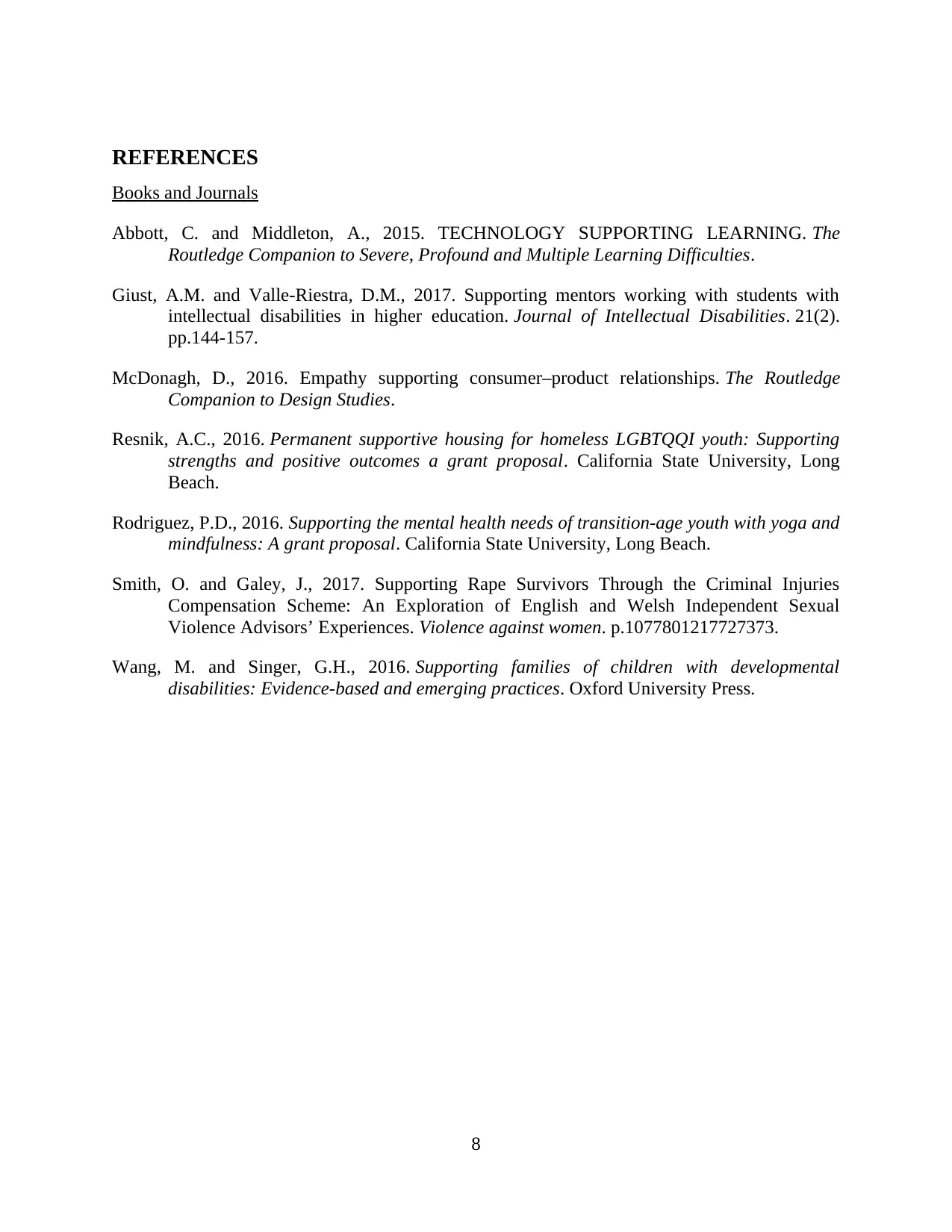
REFERENCES
Books and Journals
Abbott, C. and Middleton, A., 2015. TECHNOLOGY SUPPORTING LEARNING. The
Routledge Companion to Severe, Profound and Multiple Learning Difficulties.
Giust, A.M. and Valle-Riestra, D.M., 2017. Supporting mentors working with students with
intellectual disabilities in higher education. Journal of Intellectual Disabilities. 21(2).
pp.144-157.
McDonagh, D., 2016. Empathy supporting consumer–product relationships. The Routledge
Companion to Design Studies.
Resnik, A.C., 2016. Permanent supportive housing for homeless LGBTQQI youth: Supporting
strengths and positive outcomes a grant proposal. California State University, Long
Beach.
Rodriguez, P.D., 2016. Supporting the mental health needs of transition-age youth with yoga and
mindfulness: A grant proposal. California State University, Long Beach.
Smith, O. and Galey, J., 2017. Supporting Rape Survivors Through the Criminal Injuries
Compensation Scheme: An Exploration of English and Welsh Independent Sexual
Violence Advisors’ Experiences. Violence against women. p.1077801217727373.
Wang, M. and Singer, G.H., 2016. Supporting families of children with developmental
disabilities: Evidence-based and emerging practices. Oxford University Press.
8
Books and Journals
Abbott, C. and Middleton, A., 2015. TECHNOLOGY SUPPORTING LEARNING. The
Routledge Companion to Severe, Profound and Multiple Learning Difficulties.
Giust, A.M. and Valle-Riestra, D.M., 2017. Supporting mentors working with students with
intellectual disabilities in higher education. Journal of Intellectual Disabilities. 21(2).
pp.144-157.
McDonagh, D., 2016. Empathy supporting consumer–product relationships. The Routledge
Companion to Design Studies.
Resnik, A.C., 2016. Permanent supportive housing for homeless LGBTQQI youth: Supporting
strengths and positive outcomes a grant proposal. California State University, Long
Beach.
Rodriguez, P.D., 2016. Supporting the mental health needs of transition-age youth with yoga and
mindfulness: A grant proposal. California State University, Long Beach.
Smith, O. and Galey, J., 2017. Supporting Rape Survivors Through the Criminal Injuries
Compensation Scheme: An Exploration of English and Welsh Independent Sexual
Violence Advisors’ Experiences. Violence against women. p.1077801217727373.
Wang, M. and Singer, G.H., 2016. Supporting families of children with developmental
disabilities: Evidence-based and emerging practices. Oxford University Press.
8
1 out of 10
Related Documents
Your All-in-One AI-Powered Toolkit for Academic Success.
+13062052269
info@desklib.com
Available 24*7 on WhatsApp / Email
![[object Object]](/_next/static/media/star-bottom.7253800d.svg)
Unlock your academic potential
Copyright © 2020–2025 A2Z Services. All Rights Reserved. Developed and managed by ZUCOL.





